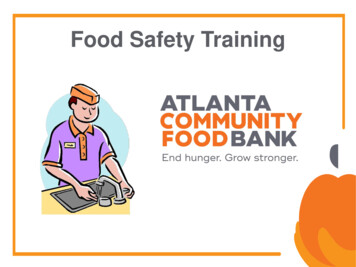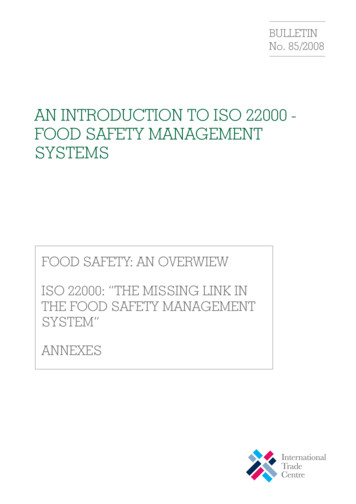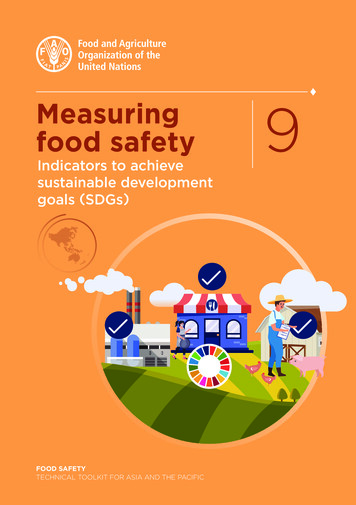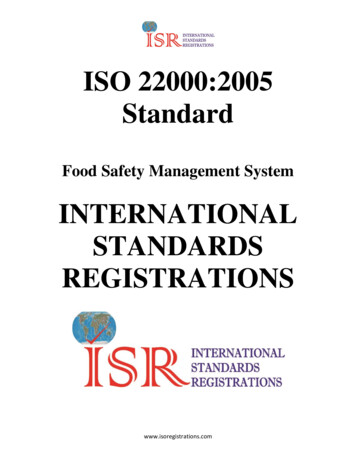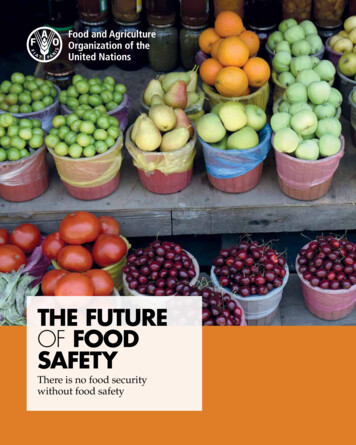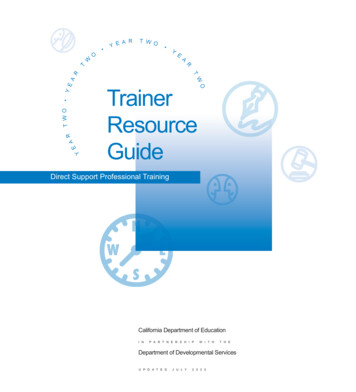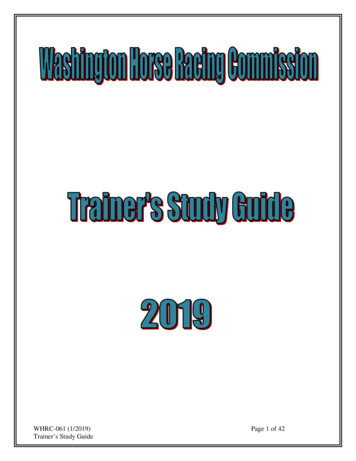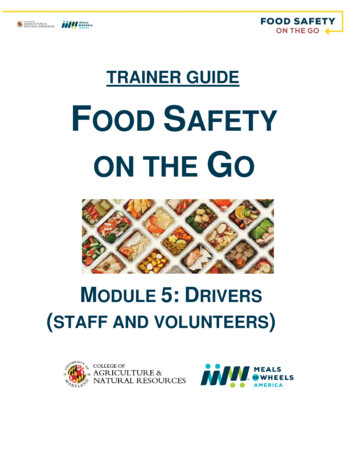
Transcription
TRAINER GUIDEFOOD SAFETYON THE GOMODULE 5: DRIVERS(STAFF AND VOLUNTEERS)
2019 EDITIONTable of ContentsINTRODUCTION2TRAINING GUIDELINES3Recommended facilities and materials3Activities3Evaluations3Training tips3MODULE 5 - DRIVERS (STAFF AND VOLUNTEERS)4Length4Audience5Purpose51. Drivers need to be in good health and maintain good personal hygiene62. Procedures for delivering safe meals9KEY POINTS14ACTIVITY: SCENARIOS AND DISCUSSION14GLOSSARY19FOOD SAFETY WEBSITES20REFERENCES221
INTRODUCTION“Food Safety on the Go” is a food safety training program for staff, volunteers andclients of home-delivered meal programs. It is made up of 6 modules. Module 1, Foodsafety basics, is an overview of food safety for all staff and volunteers. Modules 2through 5 are for specific individuals within a program: Module 2 is for the programdirector, Module 3 is for the food service management staff, Module 4 is for food serviceworkers (staff and volunteers), and Module 5 is for drivers (staff and volunteers). Module6, which is for clients, is in the form of magnets for drivers to give to clients.Module 1Food safetybasicsModule 2Program directorModule 3Food servicemanagement staffModule 4Module 5Food service workers(staff and volunteers)Drivers (staff andvolunteers)Module 6Clients educationDrivers should complete Module 1, Food safety basics, and Module 5, Drivers (staff andvolunteers), and also provide clients with magnets from Module 6, Clients.Thank you for participating in the “Food Safety on the Go” training program.2
TRAINING GUIDELINESRecommended facilities and materials Meeting room Computer with Microsoft PowerPoint softwareProjector and projection screen (or wall)PowerPoint files for the relevant modules (for the trainer)Trainer Guides for the relevant modules (for the trainer) Course Books for the relevant modules (one for each participant) Pre-tests and post-tests (one of each for each participant, for each relevantmodule) Pens/pencils (one for each participant)ActivitiesAn activity is included at the end of each module to help reinforce participants’knowledge of the material.EvaluationsA pre-test is given to participants at the beginning of each module, and a post-test at theend of each module, to help determine how useful the module is and what participantshave learned.Training tips If possible, set up the training area at least a half hour before the trainingsession. Make sure that the equipment is working properly, and that all materialsand supplies are ready. Prepare for the training session by reviewing the information in the trainerguide(s). Encourage participants to share their experiences and to ask questions. If possible, try to illustrate some points with your own experiences. Allow time for breaks if needed. Ask participants to turn off their cell phones during the training session. If you have time at the beginning of the training session, you can try to assessparticipants’ food safety knowledge by asking them if they have had food safetytraining, and if so, how much training. It can help to have an idea of the level offood safety knowledge of participants.3
MODULE 5 - DRIVERS (STAFF AND VOLUNTEERS)Length 30 minutesTrainer note Welcome participants, introduce yourself and have participants introducethemselves. Explain that “Food Safety on the Go” is a food safety course for home-deliveredmeal programs.Trainer: Go to slide 1.Trainer: Go to slide 2.4
Trainer: Go to slide 3.AudienceThis module is for drivers, both staff and volunteers, of a home-delivered meal program.PurposeThis module discusses the food safety responsibilities of drivers in a home-deliveredmeal program.Trainer note Explain that you will give participants a page with a few questions (pre-test) to try toanswer as best they can before the module, and then again after the module (posttest). Let them know that it will take about 5 minutes each time. Hand out the pre-test, and pens or pencils if needed. Give the participants 5 minutesto answer the questions, and collect the pre-tests.5
Trainer: Go to slide 4.1. Drivers need to be in good health and maintain good personal hygienea. HealthHome-delivered meal clients are at high risk of foodborne illness. To preventfoodborne illness, staff and volunteer drivers need to be in good health. Peoplewho are ill and who handle meals can transfer harmful viruses or bacteria to themeals, which can lead to foodborne illness in clients. They can also transferharmful viruses or bacteria directly to the clients, who can then become ill. If adriver is diagnosed with a foodborne illness, or shows any of the followingsymptoms, he or she should report this to the program management and beexcluded from delivering meals: vomitingdiarrheajaundice (yellowing of the skin and eyes)sore throat with feverTrainer: Go to slide 5.6
Also, any wounds on hands or arms should be covered with a clean, dry,impermeable bandage that keeps the wound from leaking. Bandages on handsshould also be covered with disposable gloves.Trainer: Go to slide 6.b. Washing handsStaff and volunteer drivers need to wash their hands properly. Washing hands isone of the best ways to reduce risk of foodborne illness, as it decreases thespread of harmful viruses and bacteria. Up to 70 percent of all infections aretransmitted by hands, and harmful bacteria and viruses can sometimes surviveon unwashed hands for hours (1).Trainer: Go to slide 7.Hands should be scrubbed in warm soapy water for at least 20 seconds beforeand after handling food, after using the restroom, after handling pets, and after7
touching one’s hair, face, body, clothing, or anything else that could contaminatehands. Hands should be dried with a clean paper towel or a hand dryer.Trainer: Go to slide 8.Drivers should clean their hands before handling any food containers during mealpick-up and delivery. It is best to wash hands with soap and clean running water.Washing hands with soap and water is more effective than using hand sanitizers,as hand sanitizers don’t remove soil and other material that might be on hands(2). However, drivers should carry alcohol-based disposable hand sanitizingwipes or hand sanitizing lotion in their vehicles, as they may not always haveaccess to soap and water during meal delivery. The lotion should have analcohol content of at least 60 percent.To use an alcohol-based hand sanitizing lotion: Apply it to the palm of one hand. Rub hands together. Rub it over all surfaces of hands and fingers until hands are dry (3).8
Trainer: Go to slide 9.c. Personal hygienePoor personal hygiene is a common cause of foodborne illness. Drivers need tohave good personal hygiene so that they don’t spread harmful viruses or bacteriato food or to other people. They should bathe or shower before delivering meals,and keep their hair and fingernails clean. Clothing can contaminate food and leadto foodborne illness. When delivering meals, drivers should wear clean clothes. Ifouter clothes such as coats and gloves or mittens are worn, it is important thatthey also be washed often and kept clean.Trainer: Go to slide 10.2. Procedures for delivering safe mealsa. Temperature requirementsi. Maintaining temperatures of meals during deliveryFood can become contaminated if it is not handled safely and kept at the correcttemperatures. Bacteria grow fastest at temperatures between 41 F and 135 F,known as the temperature “danger zone.”Trainer: Go to slide 11.9
To prevent the growth of harmful bacteria, it is very important to keep cold foodcold, and hot food hot. It is safest to keep hot food at 135 F or above, and coldfood at 41 F or below until clients receive their meals. Temperature requirementscan differ by state or region.Trainer: Go to slide 12.The time from when food is prepared to when it is eaten should be as short aspossible. The shorter a driver’s route, the less chance for harmful bacteria togrow to unsafe levels in the meals. Drivers’ routes should be as short as possiblefor both meal safety and meal quality.It is recommended that the time at which drivers pick up meals from the kitchenand deliver the meals to each client be recorded.10
Trainer: Go to slide 13.Meal temperatures should also regularly be measured and written down whenmeals are picked up from the kitchen.ii. Periodically checking temperatures during meal deliveryPreferably on a daily or weekly basis, but at least once a month, mealtemperatures should also be measured and written down on each route duringdelivery, to make sure that meals stay out of the temperature danger zone. Ontest days, the temperature of a test meal can be measured and recorded whenthe last client on a route receives his or her meal. Alternatively, program staffcould measure and record the temperature of a test meal at the end of a driver’sroute.Trainer: Go to slide 14.b. How to deliver meals safelyi. Cleanliness of delivery vehicle11
The inside of program vehicles and volunteers’ private vehicles should becleaned regularly. Program delivery vehicles should be checked for cleanlinessbefore drivers go on their routes. Volunteer drivers should remember to keep theinside of their vehicles clean. Drivers should not bring pets along in their vehiclesduring meal delivery, as pets could contaminate drivers’ hands and the meals.Trainer: Go to slide 15.ii. Appropriate containers for mealsDelivery equipment should be able to keep meals at proper temperatures at alltimes. It is recommended that insulated food containers that can keep hot food at135 F or above and cold food at 41 F or below being used. Containers should befood-grade, and designed so that food will not mix, leak or spill. They should beable to let air circulate to keep temperatures even.iii. How to handle meal containersMeal containers should be cleaned and sanitized after each use. During delivery,containers should be secured in the vehicle to keep them from moving too muchduring a route. It is very important to close insulated containers completely duringa route, and as soon as possible after removing a meal, so that meals can bekept at safe temperatures.12
Trainer: Go to slide 16.c. How clients should handle and store mealsi. Give food safety instructions to clientsClients need to eat their meals right after they receive them, or refrigerate orfreeze the meals. It is recommended that home-delivered meals be labeled with a“use-by” date, as well as instructions for storage and reheating. If the client can’tread the “use-by” date or instructions, it is important to read and explain them tothe client upon meal delivery.ii. What to do if the client is not at homeIf a client is not at home, the driver should not leave the meal, outside or inside,for the client. Leaving a meal in the temperature danger zone strongly increasesthe chance that will cause foodborne illness. Even if a client has provided aninsulated container for the meal, the container may not keep the meal at a safetemperature. There is an added risk of tampering when meals are left outside.The client may also be away from home for a longer time than planned, whichincreases the chance that the meal will become unsafe to eat.If the program allows, a meal could be left with a neighbor. In this case, it isimportant to explain to the neighbor how to store the meal.Trainer note: Explain that the key points in the course book list the main points of themodule, and are for participants to read over when they have a chance.13
KEY POINTS Staff and volunteer drivers need to be in good health and have good personalhygiene. It is very important that they wash their hands properly. It is recommended that meals be kept at safe temperatures, out of thetemperature danger zone which is between 41 F and 135 F, until clients receivethe meals. It is very important to keep cold food cold, and hot food hot. The inside of program vehicles should be cleaned regularly, and volunteerdrivers should remember to keep their vehicles clean. Delivery equipment should be able to keep meals at proper temperatures at alltimes. Meal containers should be cleaned and sanitized after each use. Clients need to eat their meals right after they receive them, or refrigerate orfreeze the meals. It is recommended that home-delivered meals be labeled witha “use-by” date, as well as instructions for storage and reheating. If the clientcan’t read the “use-by” date or instructions, it is important to read and explainthem to the client upon meal delivery. If a client is not at home, the driver should not leave the meal, outside or inside,for the client. If the program allows, a meal could be left with a neighbor. In thiscase, it is important to explain to the neighbor how to store the meal.ACTIVITY: SCENARIOS AND DISCUSSIONTrainer: Go to slide 17.Trainer note: Ask for several participants to volunteer to read scenario 1 aloud – onecould read each paragraph, for example.14
Scenario 1:Jim, a volunteer driver for a home-delivered meal program, woke up today with a sorethroat and a fever, but knew people were counting on him and decided to tough it outand go on his route. He had promised the clients on his route that he would bring hisdog Roxy along to see them.He and Roxy arrived at the first client’s house and saw a note on the door, asking him toleave the meal in a cooler that was left outside the door. Jim considered the client afriend, and wanted to be helpful, so he left the meal in the cooler. The meal containedan egg and cheese omelet with turkey sausage, seasoned broccoli, diced pears, awhole wheat roll with margarine, and 1% milk.Jim’s route covered 40 miles, and to save some time, he left the insulated mealcontainers unzipped during his deliveries so that he could take meals out more quickly.Trainer note: Ask participants to raise their hands and say whether Jim followed good food safetypractices, and if there is anything he could have done better. Go over the correct answers.Discussion question: Did Jim follow good food safety practices? Is there anythinghe could have done better?Answers: To prevent foodborne illness, drivers need to be in good health. If a driver has a sorethroat and a fever, or other symptoms mentioned in this module, he or she shouldreport this to the program management, and not deliver meals.Drivers should not bring pets along in their vehicles during meal delivery, as theycould contaminate the meals. If a client is not at home, the driver should not leave the meal, outside or inside, forthe client. Leaving a meal in the temperature danger zone strongly increases thechance that it will cause foodborne illness. Even if a client has provided an insulatedcontainer for the meal, the container may not keep the meal at a safe temperature.15
It is very important to close insulated containers completely during a route, and assoon as possible after removing a meal, so that meals can be kept at safetemperatures.Trainer note: Ask several volunteer participants to read scenario 2 aloud – one couldread each paragraph, for example.Scenario 2:Sandy, a volunteer driver for a home-delivered meal program, delivered a meal to aclient who she knew may not see anyone else all day. She stayed with the client for 45minutes and chatted while petting the client’s dog.Sandy then continued on her route, and since she was behind schedule, took out theremaining meals from the cooler and lined them up on the floor in the back seat of hercar to save time.The next client, who had arthritis, asked Sandy to open the meal tray, which Sandy didright away since she helps clients whenever she can. Sandy didn’t have a chance towash her hands during her route, but she knew she was in good health.Trainer note: Ask participants to raise their hands and say whether Sandy followed good foodsafety practices, and if there is anything she could have done better. Go over the correct answers.Discussion question: Did Sandy follow good food safety practices? Is thereanything she could have done better?Answers: Drivers need to wash their hands properly, to decrease the spread of harmful virusesand bacteria which can survive on unwashed hands for hours. Hands should bewashed in warm soapy water for at least 20 seconds before and after handling pets,and after touching anything else that could contaminate hands. Hands should bedried with a clean paper towel or a hand dryer. Drivers should clean their hands before handling any food containers during mealpick-up and delivery. It is best to wash hands with soap and clean running water.16
Washing hands with soap and water is more effective than using hand sanitizers, ashand sanitizers don’t remove soil and other material that might be on hands.However, drivers should carry alcohol-based disposable hand sanitizing wipes orhand sanitizing lotion in their vehicles, as they may not always have access to soapand water during meal delivery. The lotion should have an alcohol content of at least60 percent. To keep meals at a safe temperature, it is very important to keep them in insulatedcontainers. The containers should be closed completely during a route, and as soonas possible after removing a meal. The time from when food is prepared to when it is eaten should be short. If possible,drivers should not spend extended periods of time with a client if they haveadditional meals to deliver, so they can help keep those meals safe and maintaintheir quality.Trainer: Go to slide 18.Trainer note: Explain that you will again give participants a page with a few questions (post-test) totry to answer as best they can. Let them know that it will take about 5 minutes. Hand out the post-test, and pens or pencils if needed. Give the participants 5minutes to answer the questions, and collect the post-tests.17
18
GLOSSARYBacterium: A single-celled organism.Calibrate a thermometer: Ensure that a thermometer gives accurate readings byadjusting it to a known standard, such as the freezing point or the boiling point of water.Campylobacter: A group of bacteria, some of which can cause foodborne illness.Clean: The process of removing food residue and other types of soil from the surface ofequipment or utensil. Be sure to select right cleaning agent for food-contact surface.Contamination: The unintended presence of harmful substances or microorganisms.Cross-contamination: The transfer of harmful bacteria or viruses from one food orsurface to another.E. Coli: A group of bacteria, some of which can cause foodborne illness.Flow of food: The path food takes through a foodservice operation; it can includepurchasing, receiving, storage, preparation, cooking, holding, cooling, reheating, platingand delivery.Food Code (FDA): A model for state and local regulators to use to develop or updatetheir food safety rules. It is issued by the Food and Drug Administration (FDA), a federalgovernment agency.Food product recall: An action by a food manufacturer or distributor to removeproducts from commerce that may cause health problems or death.Food safety: The conditions and practices that preserve the quality of food to preventcontamination and foodborne illness.Foodborne illness (often called “food poisoning”): Any illness that is caused byeating food that is contaminated.Foodborne illness outbreak: An incident in which two or more people get the sameillness after eating the same food.Hazard analysis and critical control point (HACCP) system: A food safety systemthat can be used to identify, evaluate and control food safety hazards throughout theflow of food.Health inspector (may also be called sanitarian, health official orenvironmental health specialist): State, county or city employee whoconducts food service inspections.Hepatitis A virus: A virus that can cause foodborne illness.Immune system: The body’s defense system against illness.19
Infectious dose: The number of harmful bacteria or viruses that are needed to causeillness.Jaundice: Yellowing of the skin and eyes; a symptom of various diseases includinghepatitis A.Norovirus: A group of viruses that can cause foodborne illness.Personal hygiene: Maintaining cleanliness of one's body and clothing to preserveoverall health and well-being.Ready-to-eat food: Food that will be eaten without any more preparation, washing orcooking.Salmonella: A group of bacteria, some of which can cause foodborne illness.Sanitize: Reduce the number of microorganisms on a surface to safe levels.Shigella: A group of bacteria, some of which can cause foodborne illness by producingShiga toxins.Shiga toxins: One of the most potent bacterial toxins produced by the bacteriumShigella dysenteriae and some serogroups of E. coli, causing dysentery in humans.Spore: A form that some bacteria can take to protect themselves in unfavorableconditions.Temperature danger zone: The temperature range between 41 and 135 degreesFahrenheit; many bacteria that cause foodborne illness grow fastest within thistemperature range.Time-temperature abuse: Allowing food to remain too long at a temperature whichsupports the growth of harmful bacteria.Time/temperature control for safety foods (TCS foods): Foods that support thegrowth of harmful bacteria, and therefore require time and temperature control to limitthe growth of harmful bacteria.Toxin: A poison that is produced by living cells or organisms.Virus: A very small infectious agent that can only multiply inside a living cell.FOOD SAFETY WEBSITESFood safety for older orneIllnessContaminants/UCM312790.pdfFederal food safety gateway20
www.foodsafety.govU.S. Department of Agriculture (USDA) Food Safety and Inspection Servicewww.fsis.usda.govU.S. Food and Drug Administration (FDA) education resource library and retailfood otection/ucm2006807.htmPartnership for Food Safety Educationwww.fightbac.orgIowa State University Extension food safety /educators/index.cfm?articleID 295&parent 2UC Davis food safety LEDGEMENTSThis project was funded by the U.S. Department of Agriculture (USDA), NationalInstitute of Food and Agriculture, and the University of Maryland. This course wasreviewed by the U.S. Food and Drug Administration (FDA).21
REFERENCES1. The University of Arizona. UANews. Germs Spread Fast at Work, Study d-fast-at-work-study-finds. AccessedFebruary 28, 2019.2. U.S. Food and Drug Administration. Employee Health and Personal HygieneHandbook - Employee Health and the Food assistanceandtrainingresources/ucm113827.htm. Accessed January 21, 2019.3. Centers for Disease Control and Prevention. Handwashing and Hand Sanitizer Useat Home, at Play, and Out and itizer-factsheet.pdf. AccessedJanuary 17, 2019.22
Trainer: Go to slide 9. c. Personal hygiene Poor personal hygiene is a common cause of foodborne illness. Drivers need to have good personal hygiene so that they don't spread harmful viruses or bacteria to food or to other people. They should bathe or shower before delivering meals, and keep their hair and fingernails clean.


